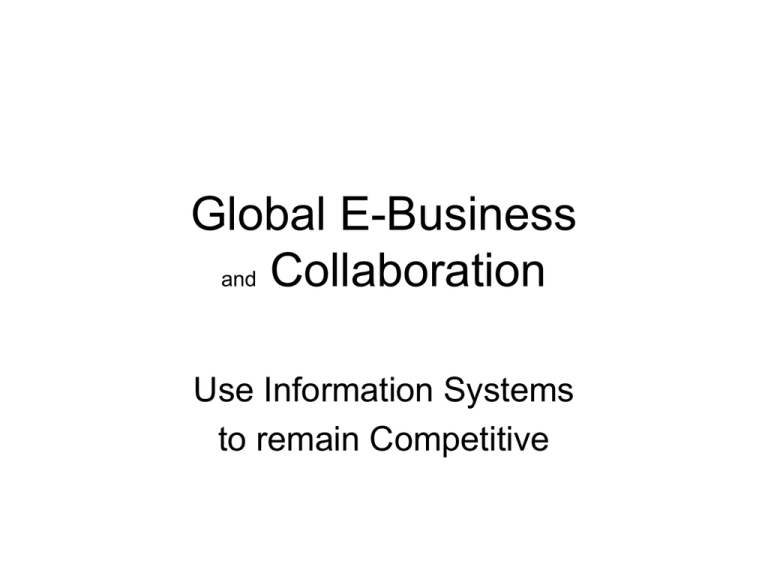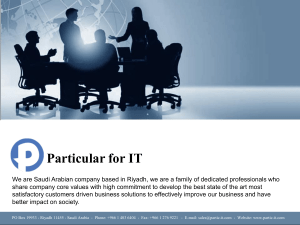Global E-Business
advertisement

Global E-Business and Collaboration Use Information Systems to remain Competitive Telus embraces social learning • Canadian Telecommunication • Wireless, Internet, Telephone • 12.7 millions user accounts – Providing superior service • Good teamwork • Good employee learning • Employee learning – Formal classroom setting • Learn from knowledgeable instructor – Social learning • • • • Learn from employees each other’s expertise Preserve employee experience and knowledge “Continuous, collaborative, connected” education Mentoring, coaching, job rotations, videos, blogs, and wikis • Microsoft SharePoint Server 2010 – Single point of entry • Share knowledge • Search learning assets – SharePoint MySites • Employees create web pages for their own area of expertise and special skills – Expert Search – Blog capabilities • My Communities • Develop from SharePoint – Project teams, departments, other groups • Work together • Share documents • Other contents – More than 1,000 videos • Learning management systems – Track and display the formal learning courses • Shift in company culture needed – Encourage acceptance and participation • Internal website to demo the new collaboration tools • Wiki to facilitate discussions 2.1 Business processes and Information systems 2.2 Types of information systems 2.3 Systems for collaboration and social business 2.4 The information systems function in business 2.1 Business Processes and Information Systems • Business process – work is organized, coordinated, and focused • to produce a valuable product and service • Hire employees • New products development – Business process • Source of competitive strength • Source of liabilities • Tied to a specific function area – Identify new customers • Cross many different functions – Order fulfillment process Order fulfillment process • How information technology improves business processes: – Efficiency and transformation • Increase efficiency of existing processes • Enable entirely new processes – Change the flow of information » More people to access and share info » Replace sequential steps with simultaneously in parallel » Eliminating delays in decision making 2.2 Types of information systems • An organization – Different interests, specialties, and level – Different kinds of systems • Systems for different management groups • Systems for linking the enterprise • E-Business, E-Commerce, and E-Government • Systems for different management groups – Transaction processing systems • Operational • Keep track of the elementary activities and transactions – POS, point-of-sale systems • Tasks, resources, and goals are predefined and highly structured • Central to a business Figure 2-2 A Payroll TPS – Business Intelligence Systems for decision support • Management information systems and • Decision-support systems – Middle management – Monitoring, controlling, decision-making, and administrative activities » Reports on the organization’s current performance • MIS – Provide info to routine, specific in advance situations • DSS – Nonroutine, not fully predefined in advance situations » What …., if » WHAT would be the impact on the production schedules IF we were to double sales in the month of December? Voyage-estimating DSS • Executive support systems – Senior management – Address strategic issues and long term trends » What product should we make in 5 years? – Incorporate data about external events » Use Portal as interface for senior management – Digital dashboard Dashboard cp. P.80 Dundas data visualization – Systems for linking enterprise • Enterprise Applications – Span functional areas, – Focus on executing business processes » Across business firm » Include all levels of management • Enterprise systems (ERP) – Enterprise resource planning – Systems for linking enterprise • Enterprise systems (ERP) – Enterprise resource planning • Supply chain management systems – SCM – Interorganizational system • Customer relationship management systems – CRM – Coordinate all activities that deal with sales, marketing, and service • Knowledge management systems – Better manage process for capturing and applying knowledge and expertise • Intranet and Extranet – Intranet: internal company websites – Extranet: company websites that are accessible to authorized external users Internet – E-Business, E-Commerce, and E-Government • Digital enabled … • The use of digital technology and the Internet to execute the major business process • Enterprise systems – ERP, enterprise resources planning – 企業資源規劃 – MIS systems can not automatically exchange information to each other – Fragmentation of data • Collecting data from various key business processes 就源輸入 Information flow as Data flow Customer orders sales Sales information systems accounting Accounting info systems production Production info systems Information flow with Data CENTRALIZED Customers WEB Order Master File Sales ERP Production 2.3 Systems for Collaboration and Teamwork Major components on iphone 6 main board – front side Source: http://www.techinsights.com/teardown.com/apple-iphone-6/ • Collaboration – Working with others to achieve shared and explicit goals • Short term / long term • One to one / many to many • Team – Part of a organization’s business structure • Specific mission • NASA's Curiosity rover for Mars • Reasons for Collaboration and teamwork – Changing nature of work • Primary value-adding activity for a job – Interaction: talking, emailing, presenting, and persuading – Growth of professional work • Require substantial education • Sharing information and opinions to get work done – Changing organization of the firm • Decentralization of works – Changing scope of the firm • Ford 2010 – – – – Produce about 3 million automobiles 200,000 employees 90 plants and facilities Worldwide – Emphasis on innovation • Most innovations derive from collaborations – Changing culture of work and business • Diverse teams produces better outputs • Social business – The use of social networking platforms to engage employees, customers, and suppliers • • • • Deepen interactions Continuous conversations Increasing emotional involvement Information transparency – Everyone involve in the creation of value will know much more about everyone else • Business benefits of collaboration • Requirements for collaboration • Building a collaborative culture and business process – Command and control • Old school • Top level: set business plans • Middle level: pass messages up and down, back and forth • Low level: carry the order without asking – Collaborative business culture • Build the teams • Coordinate their works • Monitor their performance • Tools and technologies for collaboration and teamwork • Enabler: Information technology – E-mail and Instant message • Major tools – Social networking • Collaborating among interaction-based jobs – Wiki • Easy for user to contribute and edit content – Virtual Worlds • To house online meeting, training sessions, and “lounge” – Internet-Based Collaboration Environment • Virtual meeting systems – Reduce expensive extensive travel • Google Apps/Google sites – Free online service • Microsoft SharePoint – Microsoft office SharePoint Server 2010 • Lotus Notes – IBM Lotus Domino Server • Evaluating and selecting collaboration software tools 2.4 The Information System Function in Business • Formal organizational unit responsible for information technology service 資訊部門 – – – – – – – – Programmer System analyst Information systems manager Chief information officer (CIO) Chief Security officer Chief privacy office Chief Knowledge officer End users • Organizing the information systems function • Depend on the nature and interests of the firm – Decentralized – Centralized – Combined • IT governance – Strategy & policies for using information technology within an organization Interactive session (Minicase) – Technology • Schiphol international hub • P. 78 – Management • Piloting Procter & Gamble from decision cockpits • P.84



